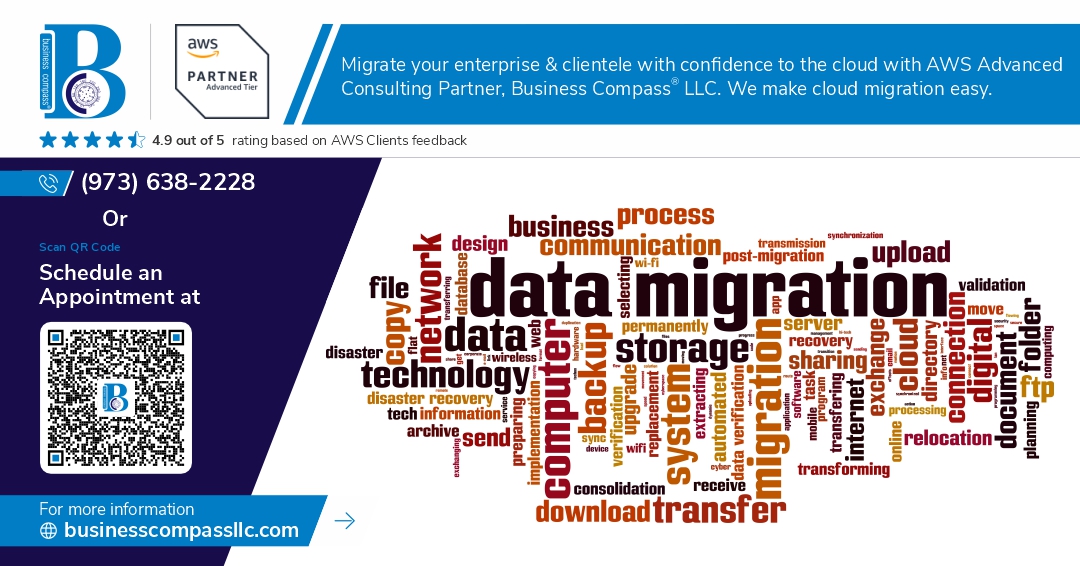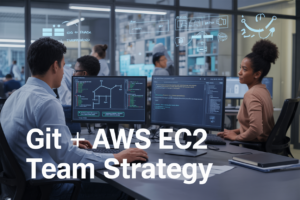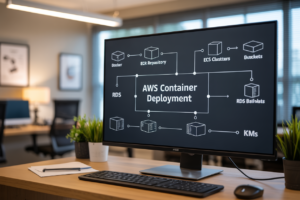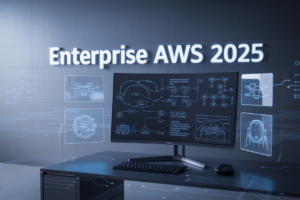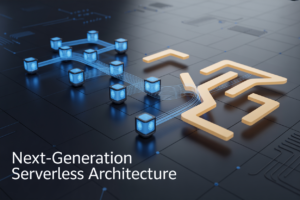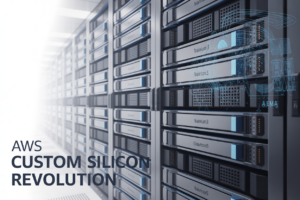Are you tired of managing your own data centers and wrestling with the complexities of on-premise infrastructure? 🤔 The cloud revolution is here, and AWS Compute Services are leading the charge. But how do you make the leap from traditional on-premise solutions to the scalable, flexible world of cloud computing?
Migrating to AWS Compute Services isn’t just a trend—it’s a game-changer for businesses seeking agility and cost-effectiveness. Whether you’re considering Amazon EC2 for virtual servers, Lambda for serverless computing, or containerization with Fargate, ECS, or EKS, the possibilities are endless. But the journey can seem daunting. Where do you start? How do you ensure a smooth transition without disrupting your operations?
In this comprehensive guide, we’ll walk you through the step-by-step process of migrating from on-premise to AWS Compute Services. From understanding the different AWS offerings to assessing your current environment, planning your strategy, and executing the migration, we’ve got you covered. Let’s dive in and explore how you can harness the power of AWS to transform your IT infrastructure and drive your business forward. 💪🚀
Understanding AWS Compute Services
Overview of EC2, Lambda, Fargate, ECS, and EKS
AWS offers a range of compute services to cater to diverse application needs:
| Service | Description | Use Case |
|---|---|---|
| EC2 | Virtual servers in the cloud | Traditional applications, full control over infrastructure |
| Lambda | Serverless compute for running code | Event-driven applications, microservices |
| Fargate | Serverless compute for containers | Container-based applications without managing servers |
| ECS | Fully managed container orchestration service | Dockerized applications, microservices architecture |
| EKS | Managed Kubernetes service | Large-scale container orchestration, hybrid deployments |
Benefits of cloud-based compute solutions
Cloud-based compute solutions offer numerous advantages over on-premise infrastructure:
- Scalability: Easily adjust resources based on demand
- Cost-effectiveness: Pay only for what you use
- Flexibility: Choose from various instance types and services
- High availability: Built-in redundancy and fault tolerance
- Global reach: Deploy applications closer to end-users
Key differences from on-premise infrastructure
When migrating from on-premise to AWS compute services, consider these key differences:
- Resource management: AWS handles hardware maintenance and updates
- Pricing model: Shift from capital expenditure to operational expenditure
- Security responsibilities: Shared responsibility model with AWS
- Networking: Software-defined networking and integration with other AWS services
- Deployment speed: Rapid provisioning and deployment of resources
Now that we’ve covered the fundamentals of AWS compute services, let’s move on to assessing your current on-premise environment to prepare for migration.
Assessing Your Current On-Premise Environment
Identifying workloads suitable for migration
When assessing your current on-premise environment for AWS migration, the first step is to identify workloads that are suitable for the cloud. Consider the following factors:
- Application architecture
- Performance requirements
- Data sensitivity
- Compliance requirements
- Scalability needs
| Workload Type | Suitability for Migration |
|---|---|
| Stateless applications | High |
| Microservices | High |
| Batch processing jobs | High |
| Legacy monolithic apps | Medium |
| Highly sensitive data | Low |
Evaluating resource requirements
Once you’ve identified potential workloads, evaluate their resource requirements:
- CPU usage
- Memory consumption
- Storage needs
- Network bandwidth
Use monitoring tools to gather accurate metrics over time, ensuring you have a comprehensive understanding of your workloads’ resource consumption patterns.
Determining migration priorities
Prioritize your migration efforts based on:
- Business impact
- Technical complexity
- Risk assessment
- Cost savings potential
- Dependencies between applications
Create a prioritization matrix to visualize and rank your workloads effectively.
Analyzing potential cost savings
Estimate the potential cost savings of migrating to AWS:
- Compare current on-premise infrastructure costs with projected AWS costs
- Consider factors like reduced hardware maintenance, power consumption, and datacenter space
- Evaluate the impact of AWS’s pay-as-you-go model on your budget
Use AWS’s Total Cost of Ownership (TCO) calculator to get a detailed cost comparison. With this assessment complete, you’re now ready to develop a comprehensive migration strategy tailored to your organization’s needs and goals.
Planning Your Migration Strategy
Choosing the right AWS compute service for each workload
When planning your migration from on-premise to AWS, it’s crucial to select the most appropriate compute service for each workload. Consider factors such as application architecture, scalability requirements, and cost-efficiency. Here’s a comparison of AWS compute services:
| Service | Best for | Scalability | Management Overhead |
|---|---|---|---|
| EC2 | Traditional applications | Manual/Auto scaling | High |
| Lambda | Event-driven, serverless | Automatic | Low |
| Fargate | Containerized apps | Auto scaling | Medium |
| ECS | Container orchestration | Auto scaling | Medium |
| EKS | Kubernetes workloads | Auto scaling | High |
Creating a detailed migration roadmap
Develop a comprehensive roadmap that outlines each step of your migration process:
- Assessment: Evaluate current infrastructure and applications
- Planning: Define migration approach (rehost, replatform, refactor)
- Preparation: Set up AWS environment and networking
- Migration: Execute the move in phases or all at once
- Testing: Validate functionality and performance
- Cutover: Switch traffic to AWS
- Optimization: Fine-tune resources and configurations
Establishing success metrics
Define key performance indicators (KPIs) to measure the success of your migration:
- Application performance improvements
- Cost savings
- Scalability enhancements
- Reduced maintenance efforts
- Improved security posture
Developing a rollback plan
Create a robust rollback strategy to mitigate risks:
- Identify critical systems and data
- Establish backup and restore procedures
- Define rollback triggers and decision-making process
- Test rollback procedures before migration
- Maintain parallel environments during initial phases
With a well-planned migration strategy, you’ll be better equipped to navigate the complexities of moving to AWS compute services. Next, we’ll delve into the crucial steps of preparing for migration, ensuring a smooth transition from your on-premise environment to the cloud.
Preparing for Migration
Setting up your AWS account and infrastructure
Before migrating to AWS compute services, it’s crucial to set up your AWS account and infrastructure properly. Start by creating an AWS account if you haven’t already. Then, follow these steps:
- Set up AWS Organizations for multi-account management
- Enable AWS CloudTrail for auditing and compliance
- Configure AWS Identity and Access Management (IAM) for secure access control
- Set up AWS Cost Explorer for budget monitoring
| Step | Purpose | Key Considerations |
|---|---|---|
| AWS Organizations | Multi-account management | Centralized billing, security policies |
| CloudTrail | Auditing and compliance | Log retention, multi-region logging |
| IAM | Access control | Least privilege principle, MFA |
| Cost Explorer | Budget monitoring | Cost allocation tags, budgets, alerts |
Configuring networking and security groups
Proper networking and security configurations are essential for a smooth migration. Follow these best practices:
- Design your VPC architecture
- Set up subnets (public and private)
- Configure route tables and internet gateways
- Create and configure security groups
Remember to implement network segmentation and follow the principle of least privilege when setting up security groups.
Creating and testing backup strategies
Developing a robust backup strategy is crucial for data protection and disaster recovery. Consider the following:
- Use AWS Backup for centralized backup management
- Implement cross-region backups for critical data
- Set up automated backup schedules
- Regularly test your backup and restore processes
Training your team on AWS services
Ensure your team is well-prepared for the migration by providing comprehensive training on AWS services. Focus on:
- AWS fundamentals and best practices
- Specific compute services (EC2, Lambda, Fargate, ECS, EKS)
- AWS security and compliance
- Cost optimization techniques
Consider leveraging AWS Training and Certification programs for structured learning paths. With these preparations in place, you’ll be well-positioned to begin the actual migration process to AWS compute services.
Migrating to Amazon EC2
Selecting appropriate instance types
When migrating to Amazon EC2, choosing the right instance type is crucial for optimal performance and cost-efficiency. Consider the following factors:
- CPU, memory, and storage requirements
- Network performance needs
- Cost considerations
- Scalability potential
Here’s a comparison of popular EC2 instance types:
| Instance Type | vCPUs | Memory (GiB) | Use Case |
|---|---|---|---|
| t3.micro | 2 | 1 | Low-traffic web servers |
| c5.large | 2 | 4 | Compute-intensive applications |
| r5.large | 2 | 16 | Memory-intensive workloads |
| i3.large | 2 | 15.25 | High I/O databases |
Transferring data and applications
To migrate your data and applications to EC2:
- Use AWS Database Migration Service for database transfers
- Leverage AWS DataSync for large-scale file transfers
- Implement AWS Application Migration Service for app migrations
- Consider AWS Snow Family devices for offline data transfer
Configuring auto-scaling and load balancing
Implement Auto Scaling groups to automatically adjust the number of EC2 instances based on demand. Pair this with Elastic Load Balancing to distribute traffic across multiple instances, ensuring high availability and improved performance.
Key steps:
- Define scaling policies based on metrics like CPU utilization or network traffic
- Set up target tracking scaling for maintaining specific metric values
- Configure Application Load Balancer for HTTP/HTTPS traffic distribution
Optimizing EC2 instances for performance and cost
To maximize EC2 performance while minimizing costs:
- Utilize Amazon CloudWatch for monitoring and alerting
- Implement AWS Cost Explorer to analyze and optimize spending
- Consider Reserved Instances or Savings Plans for long-term workloads
- Use Spot Instances for fault-tolerant, flexible workloads
By following these strategies, you’ll ensure a smooth migration to Amazon EC2 and set the foundation for efficient cloud operations. Next, we’ll explore how to leverage AWS Lambda for serverless computing, further enhancing your cloud migration journey.
Leveraging AWS Lambda for Serverless Computing
Identifying functions suitable for Lambda
When migrating to AWS Lambda, it’s crucial to identify which functions are best suited for serverless architecture. Ideal candidates for Lambda include:
- Event-driven tasks
- Periodic batch jobs
- Short-running processes
- Stateless operations
Here’s a comparison of function types and their suitability for Lambda:
| Function Type | Suitability | Reason |
|---|---|---|
| Event-driven | Excellent | Aligns with Lambda’s trigger-based execution |
| Batch jobs | Good | Can be scheduled and executed efficiently |
| Long-running | Poor | May exceed Lambda’s execution time limits |
| Stateful | Poor | Lambda functions are inherently stateless |
Refactoring applications for serverless architecture
To optimize your applications for Lambda:
- Break monolithic applications into smaller, independent functions
- Remove dependencies on local file systems
- Utilize AWS services for state management (e.g., DynamoDB, S3)
- Implement proper error handling and retries
Integrating Lambda with other AWS services
Lambda seamlessly integrates with various AWS services, enhancing its capabilities:
- API Gateway: Create serverless APIs
- S3: Trigger functions on file uploads
- DynamoDB: Process database streams
- CloudWatch: Schedule periodic tasks
Monitoring and optimizing Lambda functions
Effective monitoring and optimization are crucial for Lambda performance:
- Use CloudWatch Logs for function logging
- Set up CloudWatch Alarms for error rates and duration
- Leverage X-Ray for tracing and debugging
- Optimize function memory and timeout settings
By following these guidelines, you can effectively leverage AWS Lambda for serverless computing in your migration journey. Next, we’ll explore containerizing applications with AWS Fargate and ECS, which offers another powerful approach to modernizing your infrastructure.
Containerizing Applications with AWS Fargate and ECS
Creating and optimizing Docker containers
When containerizing applications for AWS Fargate and ECS, creating efficient Docker containers is crucial. Start by selecting a lightweight base image and optimizing your Dockerfile:
- Use multi-stage builds
- Minimize layer count
- Leverage caching
- Remove unnecessary files
Here’s an example of an optimized Dockerfile:
FROM node:14-alpine AS builder
WORKDIR /app
COPY package*.json ./
RUN npm ci
COPY . .
RUN npm run build
FROM node:14-alpine
WORKDIR /app
COPY --from=builder /app/dist ./dist
COPY package*.json ./
RUN npm ci --only=production
EXPOSE 3000
CMD ["node", "dist/index.js"]
Setting up ECS clusters and task definitions
To set up ECS clusters and task definitions:
- Create an ECS cluster
- Define task definitions
- Configure container settings
- Specify resource requirements
| Component | Description |
|---|---|
| Cluster | Logical grouping of EC2 instances or Fargate tasks |
| Task Definition | Blueprint for your application |
| Container | Docker container with your application code |
| Service | Maintains desired number of tasks |
Deploying containers using Fargate
Fargate simplifies container deployment by managing the underlying infrastructure. To deploy:
- Create a Fargate task definition
- Configure networking (VPC, subnets, security groups)
- Set up an ECS service
- Define scaling policies
Managing container orchestration and scaling
ECS provides powerful orchestration and scaling capabilities:
- Use service auto scaling to adjust task count based on metrics
- Implement rolling updates for zero-downtime deployments
- Configure task placement strategies for optimal resource utilization
- Leverage service discovery for inter-service communication
With these strategies in place, you can effectively containerize and manage your applications using AWS Fargate and ECS. Next, we’ll explore how to implement Kubernetes with Amazon EKS for more complex container orchestration scenarios.
Implementing Kubernetes with Amazon EKS
Migrating existing Kubernetes workloads
When transitioning to Amazon EKS, migrating existing Kubernetes workloads is a crucial step. Start by assessing your current Kubernetes environment and identifying the components that need migration. Use tools like eksctl or the AWS Management Console to create your EKS cluster.
- Steps for migrating Kubernetes workloads:
- Export existing manifests and configurations
- Adapt resources to EKS-specific requirements
- Test workloads in a staging environment
- Gradually migrate production workloads
Configuring and managing EKS clusters
Proper configuration and management of EKS clusters ensure optimal performance and security. Utilize AWS best practices for cluster setup, including node group configuration and networking.
| Configuration Aspect | Description |
|---|---|
| IAM roles | Set up appropriate roles for cluster and node access |
| VPC and subnets | Configure networking for cluster communication |
| Security groups | Define inbound and outbound traffic rules |
| Add-ons | Install essential add-ons like CoreDNS and kube-proxy |
Integrating EKS with other AWS services
Amazon EKS seamlessly integrates with various AWS services, enhancing your Kubernetes deployment’s capabilities. Consider integrating:
- Amazon ECR for container image storage
- AWS CloudWatch for monitoring and logging
- AWS Load Balancer Controller for efficient traffic distribution
- AWS IAM for fine-grained access control
Ensuring high availability and scalability
To maintain high availability and scalability in your EKS deployment:
- Implement multi-AZ node groups
- Use Cluster Autoscaler for automatic scaling
- Configure Horizontal Pod Autoscaler for workload scaling
- Implement proper liveness and readiness probes
By following these practices, you’ll create a robust, scalable Kubernetes environment on Amazon EKS. Next, we’ll explore post-migration optimization strategies to further enhance your cloud deployment.
Post-Migration Optimization and Management
Monitoring performance and costs
After migrating to AWS compute services, it’s crucial to closely monitor performance and costs. AWS provides robust tools like CloudWatch and Cost Explorer to help you track key metrics and optimize your spending.
| Monitoring Tool | Purpose | Key Features |
|---|---|---|
| CloudWatch | Performance monitoring | Real-time metrics, alarms, logs |
| Cost Explorer | Cost analysis | Detailed cost breakdowns, forecasting |
Use these tools to:
- Set up custom dashboards for quick insights
- Create alarms for performance thresholds
- Analyze cost trends and identify optimization opportunities
Implementing automated scaling and self-healing
AWS offers powerful auto-scaling capabilities across its compute services. Implement these features to ensure your applications can handle varying workloads efficiently and recover from failures automatically.
Key auto-scaling strategies:
- EC2 Auto Scaling groups
- Lambda concurrency scaling
- ECS and EKS cluster auto-scaling
Self-healing mechanisms:
- Health checks and instance replacement
- Automated rollbacks for failed deployments
- Multi-AZ deployments for high availability
Enhancing security and compliance
Post-migration, it’s essential to continuously enhance your security posture and maintain compliance. AWS provides a range of services to help you achieve this.
Continuous improvement and optimization strategies
To maximize the benefits of your AWS migration, adopt a culture of continuous improvement. Regularly review your architecture, costs, and performance to identify areas for optimization.
Optimization strategies:
- Right-sizing instances and containers
- Leveraging spot instances for non-critical workloads
- Implementing serverless architectures where appropriate
- Optimizing data transfer and storage costs
By focusing on these post-migration optimization and management strategies, you’ll ensure that your AWS compute environment remains efficient, secure, and cost-effective. Next, we’ll summarize the key takeaways from this guide to AWS compute migration.
Migrating from on-premise solutions to AWS Compute services offers numerous benefits, including increased scalability, flexibility, and cost-effectiveness. By carefully assessing your current environment, planning your migration strategy, and leveraging the right AWS services for your needs, you can successfully transition your infrastructure to the cloud. Whether you choose Amazon EC2 for traditional virtual machines, AWS Lambda for serverless computing, or containerization options like AWS Fargate, ECS, or EKS, AWS provides a robust ecosystem to support your applications.
Remember that migration is an ongoing process. After completing your initial move to AWS Compute services, continue to optimize your infrastructure, monitor performance, and take advantage of new features and services as they become available. With the right approach and AWS’s powerful tools at your disposal, you can transform your IT infrastructure and drive innovation in your organization.










